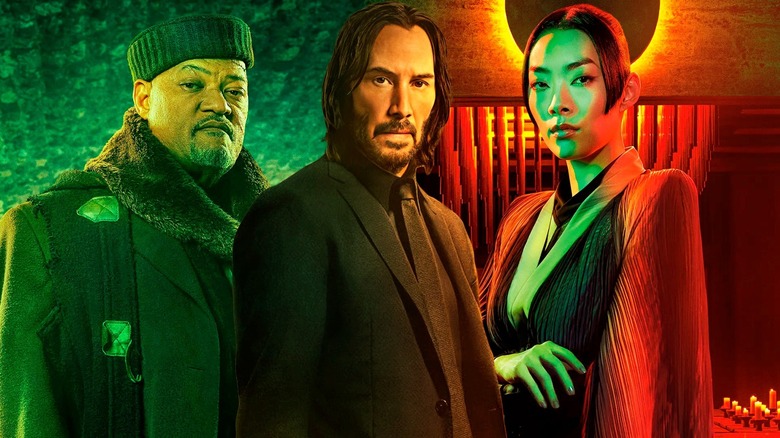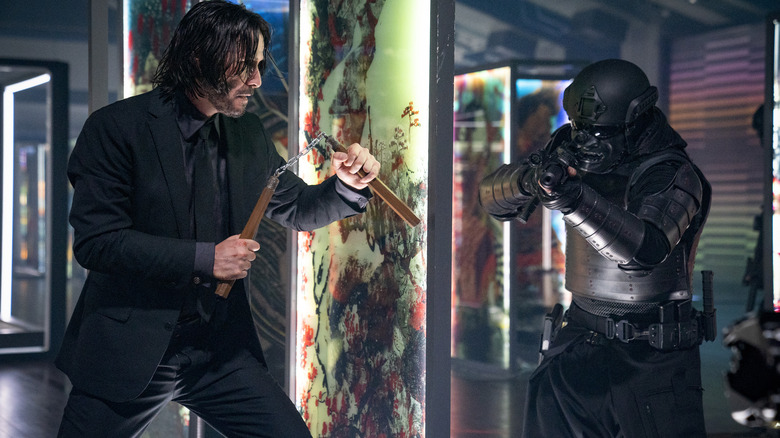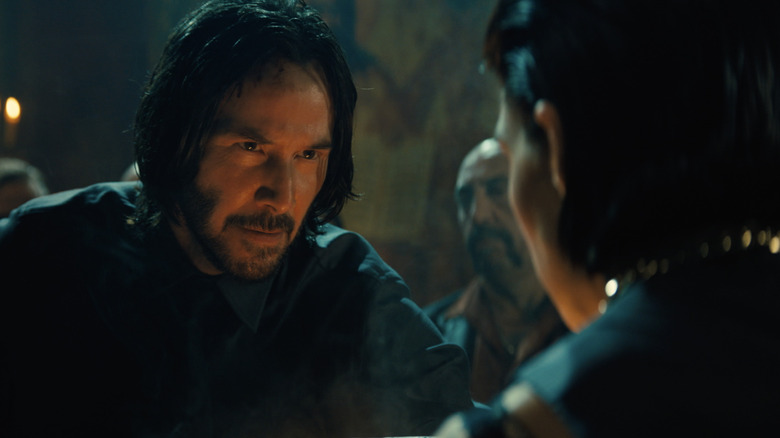John Wick: Chapter 4 Is So Good That We Don't Even Need John Wick 5 Anymore
This article contains spoilers for "John Wick: Chapter 4."
All good things must eventually come to an end — or do they?
That's the ominous question hanging heavy over the proceedings of "John Wick: Chapter 4." Long before the film's shocking ending, which strongly implies that Keanu Reeves' title character gives up the ghost and finally achieves a modicum of peace in death that he rarely found in life, the besieged assassin repeatedly runs up against the idea of what comes next. After killing the villainous Marquis de Gramont (Bill Skarsgård) and defeating rival hitman Caine (Donnie Yen) and freeing himself from the shackles of the oppressive High Table ... then what? It's almost shocking for such a proven moneymaker of a franchise to come right out and address its own sense of futility, all but turning to audiences and asking us what more we could possibly want out of future "John Wick" movies that wasn't already done (and done exceptionally well, as you can read in /Film's review of the film by Jacob Hall) in "Chapter 4."
In essence, the entirety of the fourth film argues against the continuation of its own franchise. Part of that comes from director Chad Stahelski and his army of artists staging some of the most incredible set pieces ever committed to the big screen, topping their own previous triumphs (like that knife fight in "Chapter 3") and allowing viewers to simply soak in the mind-meltingly awesome action on display until fully satisfied. But that also shines through in the very text of the film itself, giving Wick the dignity of a definitive end.
More than anything else, "Chapter 4" proves the value of a franchise bowing out at its peak.
The franchise frenzy
It might sound silly to claim that a franchise as over-the-top as "John Wick" actually exercised restraint in "Chapter 4," but that's exactly what I'm going to do. I know, I know. The seemingly never-ending parade of action sequences, the epic runtime, and literally every scene featuring Scott Adkins point to the exact opposite reality. But think about it: How easy would it have been to include all of the above in a very different story, keeping John Wick's grudge against the High Table going indefinitely for several sequels to come? In a superhero-dominated landscape where studios refuse to end anything or even take a break, working towards giving the character a true conclusion to his arc feels like a novelty these days.
Granted, even "Chapter 4" can't resist the siren call of setting up a potential spin-off or two, going so far as to include a post-credits scene hinting at how the story may continue in another form someday. At first glance, this seems no different than any other ongoing franchise out there. But, to its credit, teasing the loose thread of Rina Sawayama's vengeful assassin Akira and her grudge against Caine comes about organically, building off their motivations throughout the sequel and paying off on the running theme of actions having consequences. In fact, it doesn't feel like too much of a stretch to say that it adds even more thematic value to the story. In a cheeky way, it suggests that the cycle of violence that ended Wick's life is doomed to continue in another form with others. Wick might've received a relatively happy ending (or at least as satisfying as he could hope for), but Caine may not be so fortunate.
Either way, John Wick's chapter in this story is likely done.
End of the line
There's something to be said for the mindset of refusing to "save" narrative ideas for future sequels down the line, instead making the current movie as good as it can possibly be in the moment. Chad Stahelski took this to another level with "Chapter 4," seemingly combining story elements from what could've been a fourth and fifth film in the "John Wick" series into one mega-sized conclusion.
The fourth film alone contains multiple storylines that could've formed the backbone of several movies on their own. There's the Caine and Wick dynamic, likely one of the best character pairings we'll see all year long. The entire Osaka set piece stands out as a clear highlight, featuring a siege on Japan's Continental hotel and the conflicts brewing between Wick, his old friend and hotel manager Shimazu (Hiroyuki Sanada), and Shimazu's daughter Akira. It's difficult to believe that both of these threads not only co-exist but directly intersect with the larger A-plot concerning the Marquis attempting to tear down the mystique and aura surrounding Wick.
Stuffing "Chapter 4" to the brim with every great idea that Stahelski and writers Shay Hatten and Michael Finch could come up with only adds to the feeling that the film earned the right to go out on its own terms. Based on the early box office receipts, this series clearly still has plenty of gas left in the tank for more adventures to come. But sometimes, we get a necessary reminder that the needs of the character have to supersede the wants of an audience — no matter how voracious our appetite may be.
John Wick first arrived as a mythical figure, a Baba Yaga straight out of bedtime stories. By allowing his story to conclude, "Chapter 4" lets his legacy live on.


